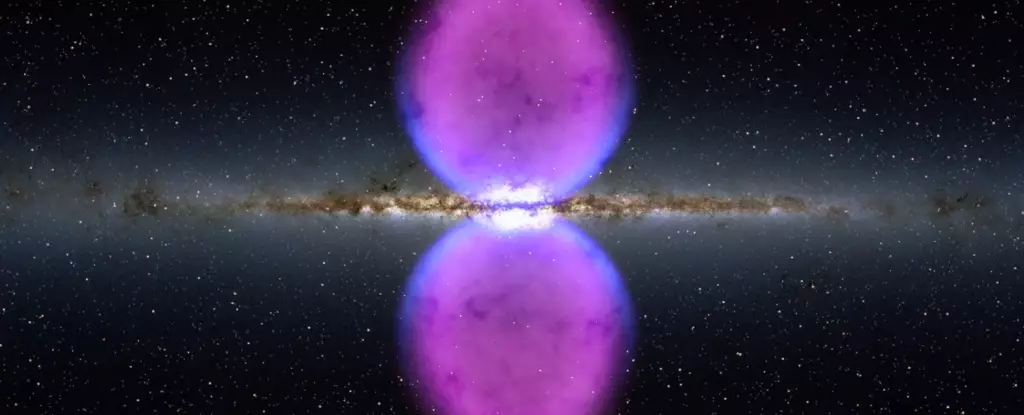The universe continually defies our expectations, especially when it comes to understanding the tumultuous environments within galaxies. Recent groundbreaking observations challenge pre-existing notions about the extreme conditions near powerful galactic phenomena. In a discovery that defies conventional wisdom, astronomers have identified cold hydrogen clouds nestled within the fiery, high-energy realm of the Fermi Bubbles—massive, luminous lobes of energetic gas extending tens of thousands of light-years from the center of the Milky Way. This revelation disrupts the long-held assumption that such hostile environments are inhospitable for cooler, denser matter, prompting a reevaluation of how galaxies handle and recycle their matter.
The Fermi Bubbles: Behemoths of Galactic Activity
The Fermi Bubbles are colossal structures, towering 25,000 light-years above and below the galactic plane. Discovered in 2010 through data from the Fermi Gamma-Ray Space Telescope, these bubbles represent an energetic upheaval of the Milky Way’s core—likely driven by a starburst event or activity of the supermassive black hole at the galaxy’s center. Their turbulent plasma reaches temperatures approaching a million Kelvin, creating a blazing, particle-filled environment akin to a cosmic furnace. Amidst this chaos, the presence of relatively cool hydrogen clouds is as surprising as finding ice cubes in a blazing volcano. These clouds are detected through radio emissions, signaling regions where hydrogen remains in a neutral, non-ionized state, defying expectations of rapid vaporization in such extreme heat.
Implications of Discovering Cold Clouds Amidst Chaos
This novel finding challenges the fundamental understanding of galactic outflows and feedback mechanisms. Traditional models posit that the energetic plasma would instantly ionize or destroy cold gas structures, rendering their existence within the Fermi Bubbles impossible. However, the detection of hydrogen clouds—some as massive as 1,470 solar masses—debunks this presumption. Their survival suggests a resilience and a more complex lifecycle for cold gas in energetic outflows than previously appreciated. Moreover, their presence implies that cooling processes, perhaps thermal instabilities or fragmentation, enable cold gas to persist even in this hot, turbulent environment. This forces astrophysicists to reconsider the efficiency of galactic feedback in clearing out or recycling matter, as well as the longevity of such cold structures within intense energy flows.
Challenging Age and Evolution Models of the Fermi Bubbles
The characteristics of these hydrogen clouds also carry profound implications for the timeline of the Fermi Bubbles’ formation. Estimated to be several million years old, they are likely remnants of earlier outflow episodes rather than products of recent activity. Their high-altitude positioning—about 13,000 light-years above the galaxy’s center—indicates that substantial amounts of cold matter can be transported far into the halo during energetic outbursts. The existence of these clouds suggests a surprisingly rapid cycling process, revealing that cold gas can endure or reform amidst intense plasma flows. This insight calls into question earlier models proposing that the bubbles could be tens of millions of years in age, favoring a shorter, more dynamic cycle of galactic feedback processes.
Reassessing Galactic Recycling: More than Hot Gas Flows
The broader significance of this discovery lies in its implications for galaxy evolution. The standard paradigm has often viewed galactic winds as predominantly hot, energy-depleting phenomena that expel material into the galaxy’s halo and beyond. However, the resilience of cold hydrogen clouds within these winds suggests a more nuanced picture. Cold gas not only survives but might also serve as the seed for future star formation, or alternatively, as a clump that fragments and dissolves over time. Its existence hints at a cyclic process where galaxies are more efficient at recycling matter than previously thought, blending the seemingly incompatible extremes of hot plasma and frigid gas in a cosmic ballet. This discovery elevates the importance of multi-phase media in shaping galaxy morphology and star formation activity.
Broader Cosmic Significance and Future Prospects
While initially observed within the Milky Way, the implications of these findings resonate across the universe. Understanding how cold gas endures or re-emerges in energetic outflows informs models of galactic evolution, feedback mechanisms, and the cosmic cycle of matter. It raises questions about the universality of these processes in other galaxies, especially those experiencing similar energetic phenomena. Future studies leveraging even more sensitive radio telescopes could unravel the lifecycle of these cold clouds, their origins—whether remnants of larger clouds or products of in-situ condensation—and their ultimate fate within the galactic ecosystem. This paradigm shift underscores the universe’s capacity for complexity and adaptability, revealing that even in the most violent cosmic arenas, delicate structures find a way to persist, challenge assumptions, and redefine what we believe is possible in galactic astrophysics.

